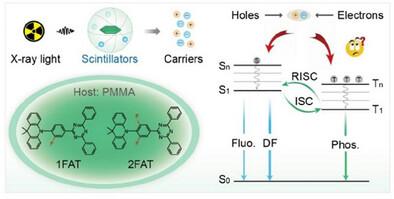当前位置:
X-MOL 学术
›
Adv. Mater.
›
论文详情
Our official English website, www.x-mol.net, welcomes your
feedback! (Note: you will need to create a separate account there.)
Efficient Organic D-π-A Scintillators for Temperature-Adaptive X-Ray Imaging
Advanced Materials ( IF 27.4 ) Pub Date : 2025-06-04 , DOI: 10.1002/adma.202507058
Jing Sun, Meijuan Ding, Huili Ma, Xiao Wang, Mengping Li, He Wang, Jikuan Du, Zixing Zhou, Anqi Lv, Hua Wang, Zhongfu An, Huifang Shi, Wei Huang
Advanced Materials ( IF 27.4 ) Pub Date : 2025-06-04 , DOI: 10.1002/adma.202507058
Jing Sun, Meijuan Ding, Huili Ma, Xiao Wang, Mengping Li, He Wang, Jikuan Du, Zixing Zhou, Anqi Lv, Hua Wang, Zhongfu An, Huifang Shi, Wei Huang

|
Achieving highly efficient organic scintillators for X-ray imaging remains a significant challenge, primarily owing to the inherent difficulty in facilitating rapid radiative decays of both singlet and triplet excitons. To address this limitation, a novel design strategy is introduced that incorporated fluorine atoms to modify the π-bridge of D-π-A molecules, thereby fine-tuning their electronic structures and photophysical properties. The emitters, namely 1FAT and 2FAT, show excellent thermally activated delayed fluorescence (TADF), aggregation-induced delayed fluorescence (AIDF), and room temperature phosphorescence (RTP) excited by ultraviolet light varying with surrounding environments. Notably, the doped PMMA film of 1FAT exhibites intense emission across a broad temperature range from 77 to 363 K, showcasing its adaptability to diverse thermal conditions. More importantly, 1FAT@PMMA film exhibits excellent radioluminescence performance under X-ray excitation with a low detection limit of 62.27 nGy s−1 and a high spatial resolution of over 20 lp mm−1. This study introduces a novel and fundamental design strategy for developing efficient, temperature-adaptive D-π-A organic scintillators, significantly expanding their potential applications in flexible, stretchable X-ray detectors and advanced imaging technologies.
中文翻译:

用于温度自适应 X 射线成像的高效有机 D-π-A 闪烁体
实现用于 X 射线成像的高效有机闪烁体仍然是一项重大挑战,主要是由于促进单重态和三重态激子的快速辐射衰变的固有困难。为了解决这一限制,引入了一种新的设计策略,该策略掺入氟原子来修饰 D-π-A 分子的π桥,从而微调它们的电子结构和光物理特性。发射器,即 1FAT 和 2FAT,表现出优异的热激活延迟荧光 (TADF)、聚集诱导延迟荧光 (AIDF) 和室温磷光 (RTP),由紫外线随周围环境变化而激发。值得注意的是,1FAT 的掺杂 PMMA 薄膜在 77 至 363 K 的宽温度范围内表现出强烈的发射,展示了其对不同热条件的适应性。更重要的是,1FAT@PMMA 胶片在 X 射线激发下表现出优异的放射发光性能,检测限低至 62.27 nGy s-1,空间分辨率超过 20 lp mm-1。本研究介绍了一种新颖的基本设计策略,用于开发高效、温度自适应的 D-π-A 有机闪烁体,显著扩展了它们在柔性、可拉伸 X 射线探测器和先进成像技术中的潜在应用。
更新日期:2025-06-04
中文翻译:

用于温度自适应 X 射线成像的高效有机 D-π-A 闪烁体
实现用于 X 射线成像的高效有机闪烁体仍然是一项重大挑战,主要是由于促进单重态和三重态激子的快速辐射衰变的固有困难。为了解决这一限制,引入了一种新的设计策略,该策略掺入氟原子来修饰 D-π-A 分子的π桥,从而微调它们的电子结构和光物理特性。发射器,即 1FAT 和 2FAT,表现出优异的热激活延迟荧光 (TADF)、聚集诱导延迟荧光 (AIDF) 和室温磷光 (RTP),由紫外线随周围环境变化而激发。值得注意的是,1FAT 的掺杂 PMMA 薄膜在 77 至 363 K 的宽温度范围内表现出强烈的发射,展示了其对不同热条件的适应性。更重要的是,1FAT@PMMA 胶片在 X 射线激发下表现出优异的放射发光性能,检测限低至 62.27 nGy s-1,空间分辨率超过 20 lp mm-1。本研究介绍了一种新颖的基本设计策略,用于开发高效、温度自适应的 D-π-A 有机闪烁体,显著扩展了它们在柔性、可拉伸 X 射线探测器和先进成像技术中的潜在应用。


















































 京公网安备 11010802027423号
京公网安备 11010802027423号